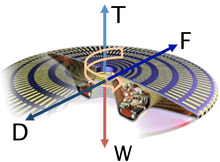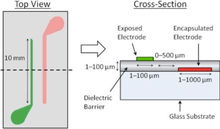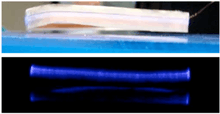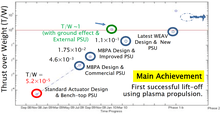Wingless Electromagnetic Air Vehicle
The Wingless Electromagnetic Air Vehicle (WEAV) is a heavier than air flight system developed at the University of Florida, funded by the Air Force Office of Scientific Research.[1][2][3] The WEAV was invented in 2006 by Dr. Subrata Roy,[4], plasma physicist, aerospace engineering professor at the University of Florida, and has been a subject of several patents.[5][6][7][8][9][10] The WEAV employs no moving parts, and combines the aircraft structure, propulsion, energy production and storage, and control subsystems into one integrated system.

Operating Mechanism
The WEAV uses a multitude of small electrodes covering the whole wetted area of the aircraft, in a multi-barrier plasma actuator (MBPA) arrangement, an enhancement over dual-electrode dielectric barrier discharge (DBD) systems using multiple layers of dielectric materials and powered electrodes.[11] These electrodes are very close to one another so surrounding air can be ionized using RF AC high voltage of a few tens of kilovolts even at the standard pressure of one atmosphere. The resultant plasma contains ions that are accelerated by the Coulomb force using electrohydrodynamics (EHD) at low altitude and small velocity. The surface of the vehicle acts as an electrostatic fluid accelerator pumping surrounding air as ion wind, radially then downward, so the lower pressure zone on the upper surface and the higher pressure zone underneath the aircraft produces lift and thrust for propulsion and stability.[1] At a higher altitude and to reach greater speeds, a magnetic field is also applied to enhance collisions between electrons and heavy species in the plasma and use the more powerful Lorentz body force to accelerate all charge carriers in the same direction along a radial high speed jet.[2] A very early version of this documented by Jean-louis Naudin used wire originally from a hard disk drive cable (aka 80/40 wire) with alternate HV on each pair and this works but is very inefficient compared to newer approaches as discussed above.
Novel Technologies
To achieve its mission, the WEAV-related research introduced a number of plasma actuator designs. This section highlights the main technologies.
Multi-Barrier Plasma Actuators


The conventional single dielectric barrier discharge (DBD) actuator design is composed of two electrodes separated by a single dielectric material. Much work has gone into optimizing the design and performance of the single DBD design,[12] however research work continues to improve the performance of these actuators. The MBPA design is an extension of the single DBD actuator design which introduces additional dielectric barriers and electrodes, and thus additional design parameters. Research indicates that MBPA designs may achieve higher resultant thrust and improved thrust-to-power ratios than the single DBD actuator design.[11][13][14] Sample trials of a bi-layer MBPA design demonstrated an approximately 40% increase in effectiveness over the conventional single layer design.[2][13]
Serpentine Actuators
The WEAV employed serpentine geometry plasma actuators for fully three-dimensional flow control which combine the effects of a linear actuator and plasma synthetic jet.[15][16][17] Due to the periodic geometry of the serpentine design, there is pinching and spreading of the surrounding air along the actuator.[18] Consequently, serpentine actuators generate both spanwise and streamwise vorticity, resulting in unique flow structures that are not reproduced by conventional linear geometry plasma actuators.
Micro-scale Actuators

Experimental results and numerical simulation demonstrate that by shrinking the gap between electrodes to micron size,[19][20][21] the electric force density in the discharge region is increased by at least an order of magnitude and the power required for plasma discharge is decreased by an order of magnitude. Consequently, physically smaller and lighter power supplies can be used with these so-called micro-scale actuators. Investigations demonstrated that per actuator, induced velocities from the micro-scale plasma actuator are comparable to their standard, macro-scale counterparts, albeit with an order of magnitude less thrust.[2] However, due to the decreased power requirements of the micro-scale plasma actuators, experiments suggest effective macroscopic flow control via large arrays of micro-scale plasma actuators.[22][23]
Novel Materials
In addition to experimental plasma actuator designs and geometries, the WEAV investigated the performance of a large variety of insulating materials for use in the dielectric barrier layer, including flexible materials such as silicone rubber and ferroelectric modified lead zirconate-titanate (PZT) and silica aerogel.[24]
| Material | Thickness (μm) |
|---|---|
| Acrylic | 500, 1000, 3000 |
| Cirlex | 254,2540 |
| PDMS (Polydimethylsiloxane) | ~1000 |
| Silicone rubber (high-purity) | 127 |
| Torlon | 250 |
| PZT | 3000 |
| Silica Aerogel | 6000 |
Liftoff


An early prototype of the WEAV was able to sustain hovering flight a few millimeters above the ground for approximately 3 minutes. Prototypes of varying radii were also successfully tested, suggesting scalability of the design.
See also
- Plasma actuator
- Ionocraft
- Lightcraft
- Electrostatic fluid accelerator
- Magnetohydrodynamic drive
References
- Greenemeier, Larry (7 July 2008). "The World's First Flying Saucer: Made Right Here on Earth". Scientific American.
- Roy, Subrata; Arnold, David; Lin, Jenshan; Schmidt, Tony; Lind, Rick; et al. (20 December 2011). Air Force Office of Scientific Research; University of Florida (eds.). Demonstration of a Wingless Electromagnetic Air Vehicle (PDF) (Report). Defense Technical Information Center. ASIN B01IKW9SES. AFRL-OSR-VA-TR-2012-0922.
- Townsend, Allie (1 July 2009). "NASA Jumps at Patent for Plasma-Powered UFO Technology". Polular Mechanics.
- "Department of Mechanical and Aerospace Engineering, University of Florida".
- US patent 8382029, Subrata Roy, "Wingless hovering of micro air vehicle", issued 2013-02-26, assigned to University of Florida Research Foundation Inc.
- US patent 8960595, Subrata Roy, "Wingless hovering of micro air vehicle", issued 2015-02-24, assigned to University of Florida Research Foundation Inc.
- Hong Kong Patent No. 1129642B Issued on June 29, 2012.
- Chinese Patent ZL200780036093.1 Issued on October 19, 2011.
- European Patent EP 2,046,640 Issued on October 12, 2011.
- Japanese Patent no. 5,220,742 granted on March 15, 2013.
- Durscher, Ryan; Roy, Subrata (January 2011). "On Multi-Barrier Plasma Actuators" (PDF). AIAA 2011-958. 49th AIAA Aerospace Sciences Meeting including the New Horizons Forum and Aerospace Exposition. Orlando, Florida. doi:10.2514/6.2011-958.
- Corke, Thomas; Enloe, Cynthia; Wilkinson, Stephen (1 January 2010). "Dielectric Barrier Discharge Plasma Actuators for Flow Control". Annual Review of Fluid Mechanics. 42 (1): 505–529. Bibcode:2010AnRFM..42..505C. doi:10.1146/annurev-fluid-121108-145550.
- Durscher, Ryan; Roy, Subrata (January 2010). "Novel Multi-Barrier Plasma Actuators for Increased Thrust". AIAA 2010-965. 48th AIAA Aerospace Sciences Meeting Including the New Horizons Forum and Aerospace Exposition. Orlando, Florida. doi:10.2514/6.2010-965.
- Erfani R, Zare-Behtash H, Hale C, Kontis K (19 January 2015). "Development of DBD plasma actuators: The double encapsulated electrode". Acta Astronautica. 109: 132–143. Bibcode:2015AcAau.109..132E. doi:10.1016/j.actaastro.2014.12.016.
- Roy S, Wang C (31 December 2008). "Bulk flow modification with horseshoe and serpentine plasma actuators". Journal of Physics D: Applied Physics. 42 (3): 032004. doi:10.1088/0022-3727/42/3/032004.
- Roth J, Sherman D, Wilkinson S (7 July 2000). "Electrohydrodynamic Flow Control with a Glow-Discharge Surface Plasma". AIAA Journal. 38 (7): 1166–1172. Bibcode:2000AIAAJ..38.1166R. doi:10.2514/2.1110.
- Santhanakrishnan A, Jacob J (19 January 2007). "Flow control with plasma synthetic jet actuators". Journal of Physics D: Applied Physics. 40 (3): 637–651. Bibcode:2007JPhD...40..637S. doi:10.1088/0022-3727/40/3/s02.
- Durscher R, Roy S (4 January 2012). "Three-dimensional flow measurements induced from serpentine plasma actuators in quiescent air". Journal of Physics D: Applied Physics. 45 (3): 035202. Bibcode:2012JPhD...45c5202D. doi:10.1088/0022-3727/45/3/035202.
- Zito J, Durscher R, Soni J, Roy S, Arnold D (8 May 2012). "Flow and force inducement using micron size dielectric barrier discharge actuators". Applied Physics Letters. 100: 193502. doi:10.1088/0022-3727/45/1/012001.
- Wang C, Roy S (10 July 2009). "Microscale plasma actuators for improved thrust density". Journal of Applied Physics. 106 (1): 013310–013310–7. Bibcode:2009JAP...106a3310W. doi:10.1063/1.3160304.
- Wang C, Roy S (28 August 2009). "Flow shaping using three-dimensional microscale gas discharge". Applied Physics Letters. 95 (8): 081501. Bibcode:2009ApPhL..95h1501W. doi:10.1063/1.3216046.
- Pescini E, De Giorgi M, Francioso L, Sciolti A, Ficarella A (May 2014). "Effect of a micro dielectric barrier discharge plasma actuator on quiescent flow". IET Science, Measurement & Technology. 8 (3): 135–142. doi:10.1049/iet-smt.2013.0131.
- Aono H, Yamakawa S, Iwamura K, Honami S, Ishikawa H (17 May 2017). "Straight and curved type micro dielectric barrier discharge plasma actuators for active flow control". Experimental Thermal and Fluid Science. 88: 16–23. doi:10.1016/j.expthermflusci.2017.05.005.
- Durscher R, Roy S (9 December 2011). "Aerogel and ferroelectric dielectric materials for plasma actuators". Journal of Physics D: Applied Physics. 45 (1): 012001. doi:10.1088/0022-3727/45/1/012001.
